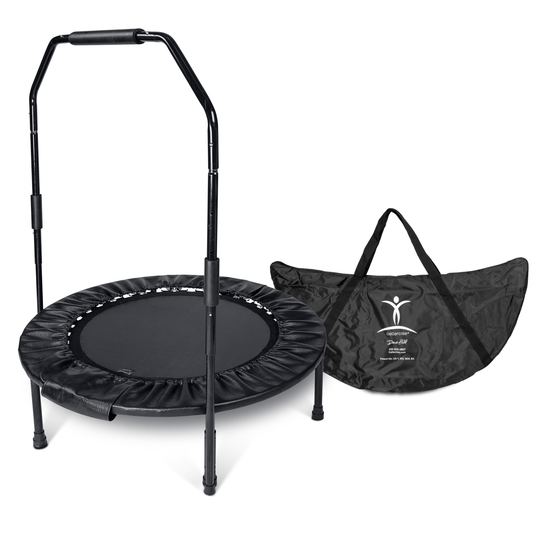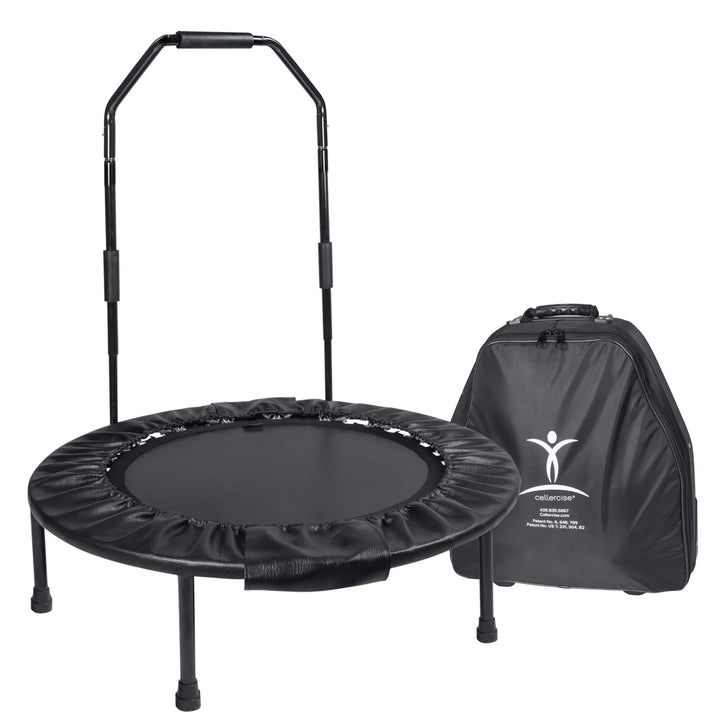How to Incinerate Fat with Rebounding
Many adults haven’t jumped on a trampoline since they were very young. This activity may not look like real exercise, but it can come with serious health benefits. Rebounding jumpstarts the metabolism, stimulates the lymphatic system, and improves cardiovascular health. It also helps people lose weight, even if they have physical limitations that keep them from participating in higher-impact exercise. Find out why rebounding is so effective for weight loss and what you can expect when you add rebounding to your fitness routine.
[quote_shortcode_1]
How Rebounding Burns Fat
Fad diets and weight loss pills might assure you weight loss is quick and easy if you just buy in, but there’s a reason they don’t work. If you want to permanently lose weight, you have to burn more calories than you consume. To lose a pound of fat, you have to create a 3,500-calorie difference between the amount you eat and the calories you burn.
There are three ways to do this:
- Eat fewer calories. Take in fewer fatty foods and processed carbohydrates and instead consume lean protein, vegetables, and whole grains.
- Do cardio exercises. Any activity that elevates your heart rate burns more calories. The longer you do it or the more intensely you participate the more calories you burn, but even low intensity activity makes a huge difference.
- Strengthen your muscles. Stronger muscles burn calories when you’re working out, and they continue to do so when you’re at rest for a 24/7 burn.
Rebounding is easy to incorporate into a comprehensive weight loss program, and it helps both raise your heart rate and strengthen muscles. Your core has to tighten and release with every jump, so training can shape abdominal muscles even better than crunches. Repeated bouncing works your legs, thighs, and buttocks to make them burn more calories at rest.
[customer_review_shortcode]
What NASA Found
One of the best weight-loss activities is running. Some people love to run, but others hate it or are unable to do it because it stresses their joints. In the 1980s, NASA commissioned a study to find a form of exercise that could allow astronauts to stay fit in a weightless environment. They found rebounding is even more effective than running. Athletes who jumped on a trampoline experienced less stress on their ankles and legs than those who ran. At the same level of exertion, athletes who rebounded gained 68 percent more oxygen uptake than those who were running.
Weight Gain and Your Immune System
The lymphatic system plays an important role in weight loss. In your body, veins carry blood to cells, organs, and connective tissue to provide oxygen and nourishment. Your lymphatic system works in a similar way, only it transports lymph instead of red blood cells.
[quote_shortcode_2]
Lymph is a syrupy, colorless fluid that is made mostly of white blood cells. Lymph washes through the body to rinse away toxins from the food you eat, germs you come into contact with, and hazards in the environment. Lymphatic vessels carry these toxins to your lymph nodes, where they’re filtered out and sent for removal. The heart pumps blood throughout the body, but even though people have three times as much lymph as blood, there’s no organ to pump it. The body depends on movement from exercise to process toxins from the body.
Since many individuals lead sedentary lives, their lymphatic systems struggle continually against inactivity and gravity, often becoming sluggish. Impaired lymphatic systems make you more likely to get sick, but they have also been linked to cellulite. Instead of being flushed from the body, toxins get trapped in small fat pockets, causing weight gain.

How Rebounding Helps
Rebounding is one of the best ways you can stimulate your lymphatic system to remove toxins and destroy cellulite. When you bounce, you cause the effect of gravity on your body to fluctuate. Think for a minute about what you felt the last time you bounced on a trampoline. At the very top of your bounce, that split second when you were in the air before you came back down, you experienced weightlessness. At the bottom of your bounce, you felt much heavier than normal as the G-force intensified. You fluctuated between zero gravity and three times the normal amount.
[advertisement_shortcode]
Rebounding stimulates T lymphocytes to strengthen immunological fitness by manipulating the effect of gravity. Muscle contraction causes lymphatic circulation to become two or three times what it is at rest. Toxins move to your lymph nodes for destruction, then you sweat them away. Australian researchers studied 204,542 adults who were middle-aged and older to see how activity-induced sweating was connected to longevity. They found sweating might prevent early death. Not only does sweating cool the body, it removes pathogens that over time can cause chronic disease and cancer. Rebounding acts as a full-body detox that cleanses every cell and removes toxic fat deposits.

How Much Can You Lose?
How much weight you lose and how quickly you lose it depends on the number of calories you take in and how much you burn when you exercise. Rebounding results vary depending on your body weight. Some people have health conditions that limit the amount of physical activity they can comfortably perform. Rebounding often provides an accessible form of exercise these individuals can participate in consistently, adding intensity as their condition improves.
At times, a hormone imbalance causes weight gain. It’s always best to consult your doctor before beginning any exercise routine.
[quote_shortcode_3]
Consistency is the key to weight loss. Not everyone has time to work out for an hour at a time, but most people can work in short bursts of physical activity throughout the day. A study in PLOS One found short bursts of interval training to be even more effective than 50 minutes of continuous exercise. With rebounding, it’s easy to get in short bursts throughout the day. You don’t need any additional equipment, just step on and start bouncing.
If you want to burn a pound a week, create a 3,500-calorie deficit by eating 250 calories less every day and burning 250 calories through exercise. Losing up to two pounds a week is safe.
To burn a significant number of calories from fat, work out between 60 and 70 percent of your maximum heart rate target. Find that number by subtracting your age from 220. For example, if you’re 42 years old, 220 – 42 = 178 beats per minute. To find 60 percent of that, multiply by the percentage expressed as a decimal, or 178 x .60 = 111. Try gently bouncing or jogging on the rebounder to elevate your heart rate to the range that’s right for you.
 Exercises to Try
Exercises to Try
People are less likely to exercise when they don’t enjoy the activity. Rebounding often makes you feel like you’re just playing around. Turn exercise into a mental break where you feel like a kid again. Stimulate your sense of fun while you activate your heart, lungs and muscles with some of these activities.
- Warm up – Step on the trampoline and gently shift your weight between one foot and the other. Gradually add a little bounce. Loosen your hips and lower back, and gradually start to move your arms as you bounce.
- Bunny hops – Use your toes, calf muscles and legs to propel you in a series of small hops. Keep your knees soft as you land. Feel the work in your thighs and buttocks.
- Jumping Jacks – Elevate your heart rate by doing the same exercise you did in high school gym, only with a bounce.
- Hop squats – This moves the legs the same way as a jumping jack. With your legs shoulder width apart, drop your weight by bending your knees at a ninety-degree angle like you’re sitting in a chair.
- Oblique twists – Do the twist while you jump to define your waist. As you jump, turn your hips one way and your shoulders the other.
[related_post_shortcode]
How to Get Started
When you first start rebounding, make sure you place your trampoline far enough away from furniture you won’t bump anything if you bounce off. If you worry about unsteadiness, choose a rebounder that comes with a safety bar you can hold on to while bouncing.
When people are overweight, they are caught in a catch-22 – they need to exercise, but the excess weight can make exercise difficult. Extra weight stresses joints in the knees and ankles, and it often causes back pain. Many forms of exercise are uncomfortable, so they’re difficult to do for any length of time. When exercise hurts, people put it off and the weight gain continues. Rebounding is a whole-body exercise anyone can do. Instead of your joints absorbing impact, the springs do it for you. Rebound at home no matter what the weather, so your routine can’t be disrupted by factors out of your control.
Start rebounding by jumping between two and five minutes at a time. Add intervals throughout the day or gradually increase the amount of time you spend bouncing for greater natural detoxification and calorie burn. Weight loss is only one of the benefits you’ll experience with a Cellerciser®. Discover why doctors and health practitioners worldwide recommend the Cellercise® program or see what products are available today.
NOTE: Remember to always consult with your doctor or health professional before starting new exercise routines.
Get Your Cellerciser® and start rebounding today!
Sources:
www.livestrong.com/article/406063-can-i-lose-weight-with-a-rebounder/
www.bodyecology.com/articles/rebounder_fitness_tool.php
www.livestrong.com/article/430476-when-to-expect-weight-loss-results-from-rebounding/
[disclaimer_shortcode]














